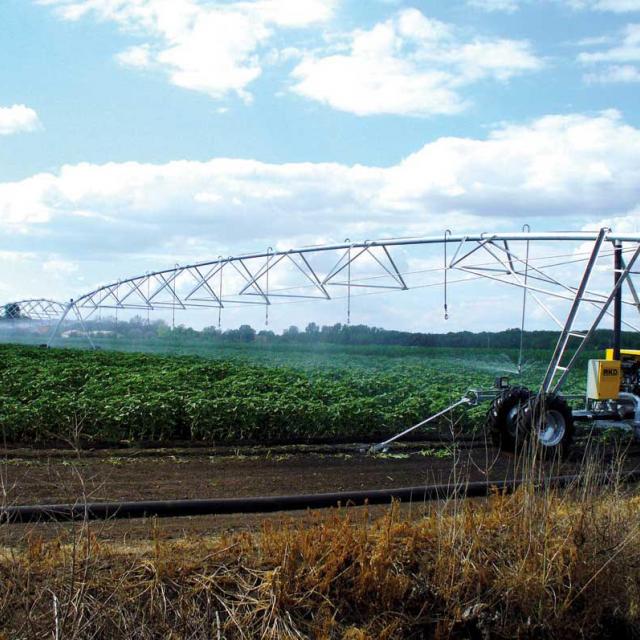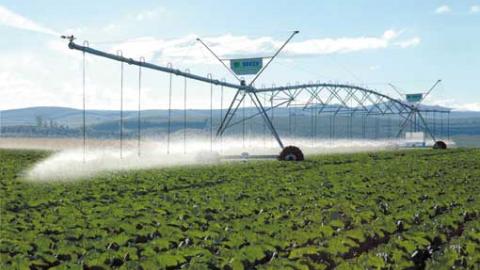The irrigation of field crops should be managed structurally. In this respect, different systems exist for a total optimisation of the irrigation of plots of land. Among the most popular, we have the central irrigation pivot consisting of spans and its precise water management system. So let us try and understand the operation of an irrigation boom or sprinkler line, which is a very distinctive system.

What is an irrigation boom?
The irrigation boom is a piece of equipment that allows field crops to be irrigated by sprinkling water. This water that is sprinkled over the whole surface of the field reproduces the same characteristics as natural rain. Therefore, depending on the layout of the field to be irrigated, sprinkling covers the area in an integrated, partial or full manner.
The different types of cover
The ideal type of cover depends on the configuration of the field to be irrigated.
Partial cover. In this system a mobile boom is equipped with sprinklers that irrigate the whole field. This irrigation boom must be moved manually which represents a certain intensity of labour. Mobile booms that move automatically now replace the manual systems. Towers that move laterally or in a circle support these booms. The system operates like an automatic irrigation pivot.
Full cover. Here, a set of booms arranged over the whole surface area to be irrigated is installed at the beginning of the setting-up process. In the present case, the amount of water planned to be used over the whole area to be irrigated is applied to a strip of the land (field). Following this, only the sprinklers need to be moved manually to cover the whole of the crop to be irrigated. Just like an irrigation pivot, irrigation is facilitated by automating certain parts of the device.
Solid set cover. Once again, a network of booms or pipes covers the whole of the field. Each of these booms is equipped with sprinklers capable of irrigating the whole surface area. No boom or sprinkler is moved during the irrigation process. Only the valves placed at the intake of each boom or sprinkler line need to be opened to allow the flow of water. These valves can also be opened manually or automatically, depending on the chosen configuration. This kind of installation is less dependent on the use of labour.
Functioning of the irrigation boom
An irrigation boom consists of several components that take the form of rapid-connection pipes. These connection components are, in turn, associated with several other parts that have a well-defined role.
Thus, the boom has sprinklers that can be of the single- or double-nozzle type. The role of these sprinklers is to discharge a jet of water. The water is then sprayed in fine droplets, reproducing rainfall. At a given pressure, the diameter of the nozzles will determine the flow rate of the water applied by the sprinkler, as well as the range of the jet and its precipitation rate, i.e. the distribution of water along the length of the jet.
Bearing in mind the fact that the amount of water applied is reduced the further it is from the sprinkler outlet, it would be advisable to lay out the sprinklers in such a way that the sprays or jets overlap each other. This allows for all the zones of the field to be irrigated uniformly.
Finally, a header pipe laid around the edge of the crop supplies the booms or lateral pipes with water. This header is also called a supply pipe.
The specific case of the irrigation pivot
The irrigation pivot is above all a completely automated device. Furthermore, irrigating with a pivot entails supplying the field with water over a part of a circle or a full rotation.
Furthermore, an electric motor drives the towers or pylon stands which move on wheels. When they are moving, these towers or pylon stands drag the irrigation boom along with them.
Possible adjustments
To achieve optimal irrigation, it is recommended that certain layout techniques should be followed.
Sprinklers
It is possible to lay out the sprinklers in a square or even triangular spacing. In windy conditions, the triangular configuration is recommended. This layout will result in a better distribution of the droplets over the ground.
Boom
As far as the boom or lateral pipe is concerned, its sizing also plays an essential role. A calculation system will consider, for example, factors such as slope, flow rate, pressure and even the diameter of the sprinklers.
Flow rate of the sprinklers
Sizing charts or spread sheet software, which can calculate the sprinklers’ flow rates, determine this according to the pressure used for applying the water emitted from the nozzles.
Water dosage
As far as the dosage or amount applied is concerned, this is determined by the farmer, according to his or her needs.
Advantages of boom irrigation
The irrigation boom thus has several advantages. In the first place, it has a good uniformity of distribution. In fact, the different systems of cover all allow for the irrigation water to be distributed evenly over the whole field.
Furthermore, their high clearance ensures that both high and low standing crops can be irrigated. This level of versatility is especially useful for large farms.
Furthermore, the irrigation booms can be used to apply fertilisers to the crops. This fertiliser introduced in this way allows for a rapid and effortless fertilisation of the plants.
Moreover, their installation does not require a great deal of labour. Their placement even allows for them to be used 24 hours a day. Thus, whether it is a manual or automatic system, in all cases their use results in considerable savings on the cost of labour.
Low flow sprinkling not only allows you to simulate the drops of rain, but it also provides certain savings. Furthermore, the reduced flow rate eliminates the phenomenon of run-off observed on many soils.
Another advantage is that the irrigation booms can be used on a wide range of topographic settings. This versatility is, therefore, in evidence, both in respect to the height of the plant and the nature of the soils.
Leakages of water on the surface are also those which. are the easiest to target. These leaks are easily identifiable with little maintenance cost. It is, therefore, possible to make savings on water without this being to the detriment of the soil, by investing in moderate maintenance measures for the irrigation boom. One of the advantages of this irrigation appliance is, therefore, that the maintenance is low cost and unrestrictive.
In conclusion, the irrigation boom is a versatile and economic irrigation system providing excellent results. Do not hesitate to contact us for more information about the different operating options, as well as learning about the different brands of each of the products and structures that we use. Forget about using second-hand equipment and invest in new equipment that will come with access to professionals who can help with your project.



